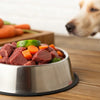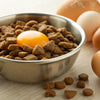Does Raw Dog Food Help with Shedding? Exploring the Connection Between Diet and Canine Coat Health
- Houndsy
Table of Contents
- Introduction
- Understanding Shedding in Dogs
- The Role of Diet in Canine Coat Health
- Implementing a Raw Food Diet Safely
- Additional Strategies to Minimize Shedding
- Conclusion
Introduction
As dog lovers, many of us face a familiar challenge: our homes seem to be perpetually covered in dog hair! In fact, studies show that around 70% of dog owners consider shedding one of the most frustrating aspects of pet ownership. While shedding is a natural process, it can escalate to a level that leaves us questioning our pets' health and well-being. Are we feeding our furry friends the right diet?
Today, we're diving into the intriguing world of canine nutrition and exploring a question many pet parents ponder: does raw dog food help with shedding? By the end of this post, we hope to uncover how your dog's diet influences shedding patterns and discuss the benefits of a raw dog food diet. We'll also review practical ways to support a healthy coat and minimize shedding, making mealtime an enriching experience for your pup.
So, grab your coffee, settle in, and let's embark on this journey together as we discover how to enhance our dog's health through optimal nutrition.
Understanding Shedding in Dogs
The Natural Shedding Cycle
It's important to first recognize that shedding is a natural part of a dog’s life cycle. Dogs shed their fur to replace old or damaged hair, allowing new growth to emerge. However, shedding patterns can vary dramatically across different breeds and seasons.
From the thick-coated Siberian Husky to hairless breeds like the Chinese Crested, the reasons behind shedding can range from simple grooming needs to complex health issues. Understanding these factors is crucial in distinguishing normal shedding from excessive hair loss, which could indicate underlying health problems.
Factors Influencing Shedding
Several elements can affect how much your dog sheds:
- Breed: Certain breeds are predisposed to heavier shedding (e.g., Golden Retrievers, German Shepherds), while others shed minimally.
- Seasonal changes: Dogs naturally shed more in spring and fall, as they transition between winter and summer coats.
- Health conditions: Issues such as allergies, skin infections, hormonal imbalances, or parasites can lead to increased shedding.
- Diet: Perhaps most importantly, what we feed our furry friends can significantly impact their coat health.
Recognizing these factors can help us make informed choices about our dog's diet and care.
The Role of Diet in Canine Coat Health
Nutritional Requirements for a Healthy Coat
A dog's coat relies heavily on its diet. The American Kennel Club emphasizes that a balanced diet can significantly improve coat health. Essential components of a dog’s diet that contribute to a healthy coat include:
- High-quality proteins: As the building blocks of fur, protein is vital for maintaining strong hair follicles.
- Essential fatty acids: Omega-3 and omega-6 fatty acids nourish the skin, reduce inflammation, and promote overall coat health.
- Vitamins and minerals: Nutrients like biotin, vitamin E, zinc, and copper help regulate skin function and oil production.
Inadequate levels of these nutrients can lead to a dull, brittle coat, which may increase shedding.
Does Raw Dog Food Help With Shedding?
Now, let’s address the burning question: Does raw dog food help with shedding? Raw dog food, often touted for its nutritional completeness, has gained popularity among pet owners looking to improve their furry friends’ health and coat condition.
Benefits of Raw Dog Food for Coat Health
- Nutrient Density: Raw diets often feature high-quality proteins and include beneficial fats, leading to healthier skin and fur.
- Essential Fatty Acids: Raw meats typically contain natural sources of omega-3 and omega-6 fatty acids, crucial for skin health. These fatty acids can help reduce inflammation and itchy skin, which can compound shedding.
- Bioavailability of Nutrients: Raw food is generally considered to be more digestible than processed kibble, allowing dogs to absorb more nutrients effectively, fueling strong hair growth.
- Less Processing: With fewer fillers and additives compared to commercial kibble, raw diets tend to be minimally processed, making them a fresher option.
Though these benefits suggest that transitioning to a raw diet could positively impact your dog’s coat health and, in turn, reduce shedding, it's essential to ensure that such a diet is well-balanced and appropriately formulated.
Implementing a Raw Food Diet Safely
Balancing Raw Diets
Switching your dog to a raw diet involves some consideration. While raw feeding can offer numerous benefits, like with any dietary change, balance is critical. A poorly formulated raw diet could lead to nutritional deficiencies, which can worsen coat quality and overall health. Here are a few tips to successfully implement a raw diet:
- Consult with a Vet or Nutritionist: Before making any changes, seek advice from a veterinary professional to create a balanced meal plan suited to your dog’s needs.
- Quality Ingredients: Opt for high-quality raw ingredients that are fresh and minimally processed. Consider brands, like Houndsy, that are made with care and have a proven commitment to quality.
- Gradual Transition: When switching to raw, it's crucial to gradually transition from your dog's current diet to avoid digestive upset. Start with small amounts of raw food mixed with kibble before fully converting.
Practical Raw Feeding Options
Some of the commonly discussed raw feeding methods include the following:
- Whole Prey Model: This method mimics a dog's natural diet, consisting of the whole animal (meat, bones, organs).
- BARF Diet (Biologically Appropriate Raw Food): The BARF diet includes raw meat, bones, vegetables, and fruits. This approach is designed to mimic the dog's ancestral diet while incorporating different food groups.
For pet parents looking for convenience without compromising quality, we at Houndsy have developed our Freeze-Dried Raw food—a balanced option that combines the best benefits of raw feeding with the ease of storage and preparation.
Additional Strategies to Minimize Shedding
While diet plays an important role in managing shedding, it is not the only factor to consider. Here are additional strategies that can help reduce shedding in your dog:
Regular Grooming
Consistent brushing is a simple yet effective way to control shedding. Regular grooming removes loose fur and dander, which can immediately reduce the amount of hair you find around your home. Additionally, brushing stimulates natural oils on your dog’s skin, promoting a healthy coat.
Maintain Hydration
Just like humans, dogs need to stay hydrated to keep their skin and coat healthy. Ensuring your dog has constant access to fresh water helps maintain skin elasticity and reduce dryness, which can lead to increased shedding.
Monitor for Allergies or Sensitivities
If you notice your dog’s shedding increases alongside scratching or red skin, your dog may have food sensitivities or allergies. Consulting with a veterinarian to diagnose and address these issues is vital.
Bathing and Skin Care
While too frequent bathing can strip the coat of important oils, gentle and infrequent baths with dog-friendly shampoos can help manage shedding. Consider using products that contain natural ingredients known to soothe skin and promote coat health.
Conclusion
We hope this exploration of raw dog food and its potential impact on shedding offers valuable insights into enhancing your furry friend's health. While raw diets can be beneficial, they need to be implemented thoughtfully to ensure they are balanced and nutritionally complete.
As we learn more about canine nutrition and its influence on shedding, we encourage you to explore high-quality feeding options that align with your dog's needs, such as our Houndsy Kibble Dispenser. Not only does it effectively simplify meal times, but it also ensures your pet receives perfectly portioned food without the mess or hassle.
Think about your dog’s diet today—could switching to raw food make a difference? Perhaps it’s time to rethink mealtime and simplify the daily feeding routine. For more insights, don't hesitate to check out our range of innovative products here.
FAQ
Q: How often should I groom my dog to manage shedding? A: The frequency of grooming depends on the breed. Generally, brushing at least once a week is a good start, while long-haired breeds may require daily grooming.
Q: Is raw dog food safe for my pet? A: Yes, raw dog food can be safe if it's balanced and prepared correctly. Always consult with your veterinarian when changing your pet's diet.
Q: How can I tell if my dog is shedding excessively? A: If you notice patches of bald skin, your dog is losing more fur than usual, or if they are constantly scratching, these may be signs of excessive shedding.
Q: Can diet alone prevent shedding? A: While a healthy diet can significantly improve coat health and reduce shedding, other factors such as grooming and health conditions also play critical roles.
Q: What are the signs of a healthy coat? A: A shiny, smooth coat with minimal odor and no dry patches indicates good coat health. Your dog's skin should also be free of redness and irritation.













